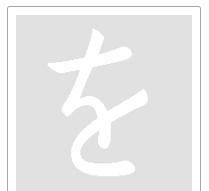 |
||||
 |
||||
Hiragana for phrase-particles |
||||||||||
|
To complete the hiragana Chapters, you need to learn one more character: を. Practice how to write を
following
the video. |
||||||||||
|
を (w)o
This is how to draw the character を. It is composed of three strokes.
を is used only for the phrase-particle o, which is explained in Lesson 22 of the SUN textbook. Although its pronunciation in modern Japanese is exactly the same as お, it used to be pronounced wo. For this reason, it can be obtained by spelling wo on the computer. |
|
|||||||||
Read the following
sentences and compare with the recording:
Write the sentences above, in the window below. Your PC should support Japanese characters. Before we close this Chapter, take note that though hiragana spelling is basically regular and straightforward, there are a few points to pay attention to: (1) は is read wa when used as a phrase-particle. (2) へ is read e when used as a phrase-particle. (3) Words containing an ei sound tend to be pronounced ee, such as kiree for きれい (kirei), eego for えいご(eigo), etc. (4) Words containing an ou sound tend to be pronounced oo, such as ohayoo for おはよう
(ohayou), doozo
for どうぞ(douzo), soo
desu for そうです
(sou desu), etc. Now that you have become able to read all
hiragana and katakana characters, you should basically be able to read any writing as long as it is
written in these two types of characters. Restaurant menus, for instance, are most likely written in katakana if the
restaurant offers Western food. Many traditional Japanese restaurants show their menus in hiragana. Many toilet articles like shampoos,
conditioners, etc. write their names in katakana. All stations exhibit their names in hiragana as well as Roman letters. When it comes to
actual reading materials, books for pre-school age children are probably the only document written only in hiragana. Unfortunately, this is about
the only place where these two types of characters are
exclusively used. In real adult readings, such as books, magazines, newspapers, etc., kanji are invariably used together with hiragana and
katakana, to indicate the core parts of many words. |
||||||||||



